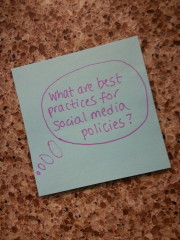During the past several years, those of us with careers as social media, marketing, and public relations professionals have seen some crazy changes to the way we all conduct business – the rise and fall of numerous platforms, continual search algorithm updates, and constant upheaval in how we choose to interact with consumers.
The one unchanging variable through all of that chaos has always been the need for communication with legal teams to make sure we aren’t getting ourselves into trouble. And nothing is more important to coordinate with those legal experts than your company’s social media policy.
Do We Really Need a Social Media Policy?
I’m still taken aback when I work with consult clients or even executive members and I’m asked if they really need an official policy for social.
Yes. Yes, you do.
Not only does this policy provide protection for any employer, it establishes a set of common ground rules by which every employee must play. Does this mean it needs to be some intimidating, 40-page document that requires a notary? Not at all. But it does mean the company’s expectations of those involved directly – and indirectly – with social media should be clearly defined.
Avoid Legalese
When was the last time you actually read through all the fine print when agreeing to your iTunes upgrade? If you’re like most people, it’s never.
This is the opposite approach that needs to be taken when crafting your own social media policy. Spell it out in plain language and consider asking a friend or family member outside of the company to read through a close-to-final draft just to see if it’s too jargony. If they run into issues understanding what you are trying to convey, the odds are good others will as well.
As with other digital communications, potency is key. If you can say something in 50 words don’t bother using 100.
Show, Don’t Tell
We preach this tactic in our external communications all the time, but we seem to forget about it when crafting internal documents. Some tips that I’ve found to be very effective:
- Use screenshots of actual tweets and Facebook posts (with names redacted or changed) and explain why those posts were acceptable or unacceptable.
- If screenshots of actual tweets aren’t available, create examples that fit various scenarios.
- If the policy is specific to the team executing your social media tactics, use diagrams to break down individual platforms and where admin functions are located on each.
- Give boilerplate examples of any disclaimers that might need to be included when employees are discussing where they work or direct competition.
Common Sense Isn’t So Common
Now, this doesn’t mean you need to treat the employees signing these policies like infants, but it does mean that you can’t simply rely on an individual’s own good judgment. We all have good and bad days at work and a normally calm individual can fly off the handle with little warning.
No matter the approach you choose to use when putting together your own policies, be sure to buddy up with your in-house or consulting legal and human resource teams. Too often these folks are viewed as adversaries when they can easily be some of your greatest champions – provided you keep them in the loop.
P.S. Don’t forget we’re hosting the Future of Content Marketing webinar on Thursday.
